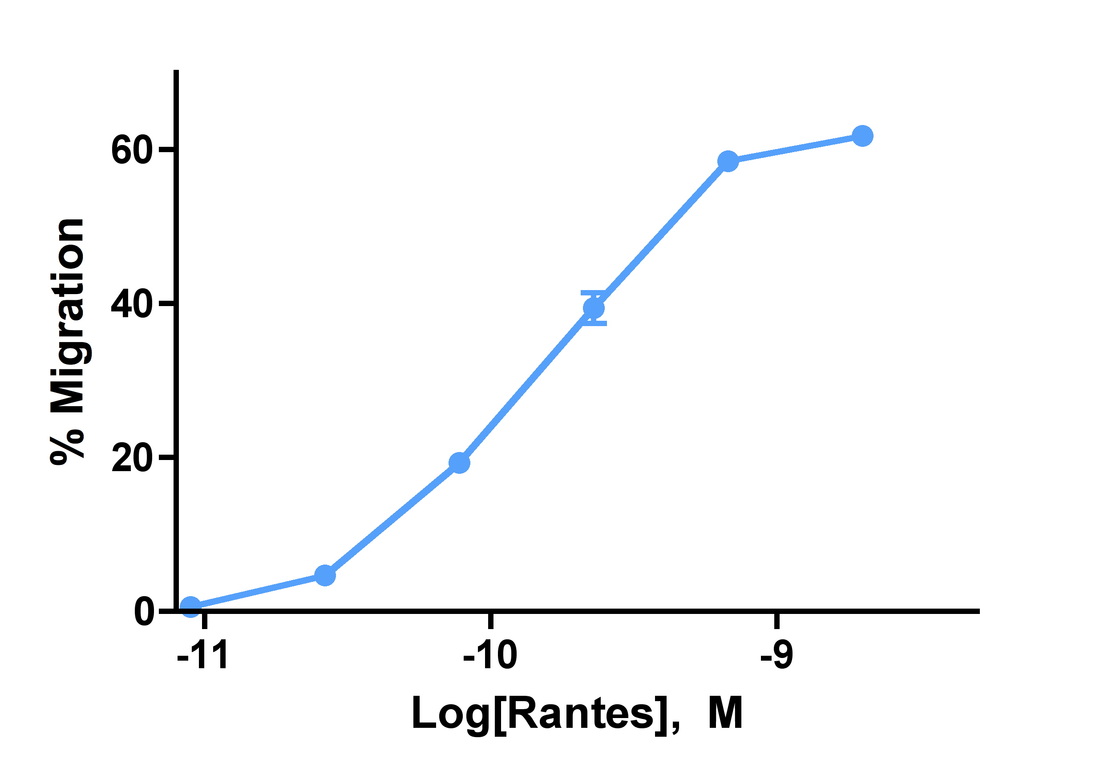Human CCL5 (RANTES)
|
Stock Sizes: 5ug, 20ug, 50ug, 100ug, and 1mg
Also available in custom sizes, email for a custom quote. |
BACKGROUND
Regulated on Activation, Normal T cell Expressed and Secreted (RANTES) (CCL5) is a proinflammatory chemokine that induces migration and activation of leukocytes, as well as implication in HIV infection. It binds to cell surface receptors CCR1, CCR3, CCR4, and CCR5. Its biological effects on leukocyte activation and HIV infection displays dependence on concentration and on the binding of cell surface glycosaminoglycans.
Regulated on Activation, Normal T cell Expressed and Secreted (RANTES) (CCL5) is a proinflammatory chemokine that induces migration and activation of leukocytes, as well as implication in HIV infection. It binds to cell surface receptors CCR1, CCR3, CCR4, and CCR5. Its biological effects on leukocyte activation and HIV infection displays dependence on concentration and on the binding of cell surface glycosaminoglycans.
|
SPECIFICATIONS
Source: E. coli derived Accession # P13501 (24-91) Modification: None Formulation: Lyophilized Carrier Protien: None Predicted Molecular Mass: 7.851 kDa Extinction Coefficient: 12,570 M-1 cm-1 Actual Molecular Mass: 7.851 kDa by ESI Mass Spec Protein Sequence: SPYSSDTTPCCFAYIARPLPRAHIKEYFYTSGKCSNPAVVFVTRKNRQVCANPEKKWV REYINSLEMS Endotoxin Level: <0.01 EU per 1μg of the protein by the LAL method Purity: > 97% by SDS PAGE PREPARATION AND STORAGE
Reconstitution: Spin sample prior to reconstitution. Recommended at 100μg/mL in sterile water Shipping: Room Temp Stability and Storage: Avoid repeated freeze-thaw cycles • 12 months from date of receipt, -20 to -70 °C as supplied. • 1 month, 2 to 8 °C under sterile conditions after reconstitution. • 3 months, -20 to -70 °C under sterile conditions after reconstitution. |
Migration Assay: Cells expressing recombinant CCR5 were assayed for migration through a transwell filter at various concentrations of Rantes. Responses are expressed as the % of total input cells.
Migration Assay Protocol Activity: EC50 = 0.13nM determined by migration assay with cells expressing recombinant CCR5
|
For bulk orders or custom sizes, please contact us and we can provide this for you.
|
|
|
|
|
|
REFERENCES
1. “RANTES: a versatile and controversial chemokine” Appay V., Rowland-Jones S.L. Trends Immunol 22:83-87 (2001)
2. “Identification of RANTES, MIP-1, and MIP-1[1] as the major HIV-suppressive fac tors produced by CD8+T cells” Cocchi F., De Vico A.L., Garzino-Demo A., Arya S.K., Gallo R.C., Lusso P. Science 270:1811-1815 (1995)
3. A human T cell-specific molecule is a member of a new gene family. Schall T.J., Jongstra J., Dyer B.J., Jorgensen J., Clayberger C., Davis M.M., Krensky A.M. J Immunol 141:1018-1025 (1988)
4. “Engineering the glycosaminoglycan-binding affinity, kinetics and oligomerization behavior of RANTES: a tool for generating chemokine-based glycosaminoglycan antagonists” Brandner B., Rek A., Diedrichs-Möhring M., Wildner G., Kungl A.J. Protein Eng Des Sel. 22:367-373 (2009)
1. “RANTES: a versatile and controversial chemokine” Appay V., Rowland-Jones S.L. Trends Immunol 22:83-87 (2001)
2. “Identification of RANTES, MIP-1, and MIP-1[1] as the major HIV-suppressive fac tors produced by CD8+T cells” Cocchi F., De Vico A.L., Garzino-Demo A., Arya S.K., Gallo R.C., Lusso P. Science 270:1811-1815 (1995)
3. A human T cell-specific molecule is a member of a new gene family. Schall T.J., Jongstra J., Dyer B.J., Jorgensen J., Clayberger C., Davis M.M., Krensky A.M. J Immunol 141:1018-1025 (1988)
4. “Engineering the glycosaminoglycan-binding affinity, kinetics and oligomerization behavior of RANTES: a tool for generating chemokine-based glycosaminoglycan antagonists” Brandner B., Rek A., Diedrichs-Möhring M., Wildner G., Kungl A.J. Protein Eng Des Sel. 22:367-373 (2009)




